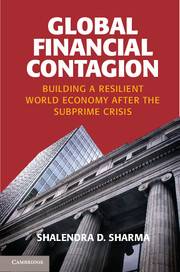Book contents
- Frontmatter
- Contents
- List of Figures
- List of Tables
- Acknowledgments
- Introduction
- One The United States
- Two The Bush and Obama Administrations’ Response
- Three From the U.S. to the European Crisis
- Four The Eurozone’s Sovereign-Debt Crisis
- Five Russia
- Six China
- Seven Japan, South Korea, and India
- Eight The Middle East amid the Global Financial Crisis
- Nine The Great Recession and the World’s Poorest
- Ten G-20 World
- Bibliography
- Index
Nine - The Great Recession and the World’s Poorest
Published online by Cambridge University Press: 05 June 2014
- Frontmatter
- Contents
- List of Figures
- List of Tables
- Acknowledgments
- Introduction
- One The United States
- Two The Bush and Obama Administrations’ Response
- Three From the U.S. to the European Crisis
- Four The Eurozone’s Sovereign-Debt Crisis
- Five Russia
- Six China
- Seven Japan, South Korea, and India
- Eight The Middle East amid the Global Financial Crisis
- Nine The Great Recession and the World’s Poorest
- Ten G-20 World
- Bibliography
- Index
Summary
In an ironic and cruel twist the global economic crisis emanated from the world’s largest and most advanced economy (the United States) rather than from the profligacy and mismanagement typically associated with the emerging-market and developing countries. In fact, when the subprime-induced global crisis broke out in the United States in mid-2007, the macroeconomic positions of most developing countries, including the large emerging market economies such as China, India, Brazil, as well as many of the world’s least-developed countries (LDCs) were robust (AfDB 2010; World Bank 2007). The economic prospects for sub-Saharan Africa had never looked brighter (World Bank 2008b). For the first time in decades the region’s GDP was growing at a comparable rate with the rest of the developing world – except China and India (Tables 9.1 and 9.2). Private-capital flows to Africa totaled an unprecedented $55 billion by the end of 2007 (World Bank 2008a; Ezekwesili 2009). Similarly, FDI flows to LDCs saw dramatic expansion – a sixfold increase between 2000 and 2008. On the eve of the crisis FDI flows exceeded $32 billion (UNCTAD 2010, 7). Coupled with extensive debt relief (mostly in the form of debt write-offs) under the HIPC (Heavily Indebted Poor Countries Initiative) and the Multilateral Debt Relief Initiative (MDRI) and adoption of prudent policies, many LDCs were finally able to reduce their external debt burdens and improve the living standards of their citizens.
- Type
- Chapter
- Information
- Global Financial ContagionBuilding a Resilient World Economy after the Subprime Crisis, pp. 279 - 294Publisher: Cambridge University PressPrint publication year: 2013



